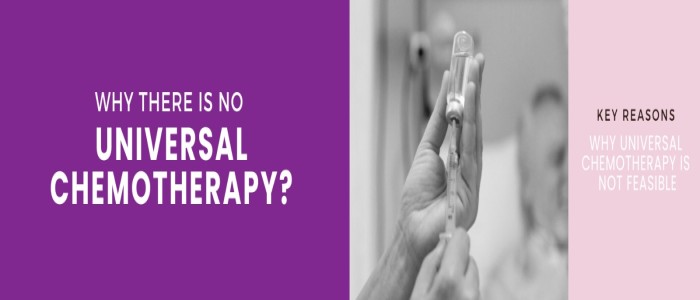Admin
13 November, 2025
Imagine how hopeful it would be if doctors could give every cancer patient the same pill – one magic drug that cured all cancers, regardless of size, site and stage. That idea sounds optimistic, even logical. After all, every cancer shares the same basic problem: cells that grow uncontrollably. Shouldn’t one strong medicine that stops dividing cells work for all?
Cancer is not a single disease but a collection of more than 200 distinct diseases, each with its own unique molecular and genetic profile. Chemotherapy drugs are not ‘poisons’ as often imagined in the loose sense. They are cell- cycle disruptors designed to interrupt cancer cells from dividing and growing.
Yet, more than a century after chemotherapy was born, we know this simple idea does not hold true. There is no universal chemotherapy, and likely never will be. But the reasons are not failures of science – but as a result of how beautifully complex and unique our biology is making one size-fits all treatment approach impossible.
Key reasons why universal chemotherapy is not feasible:
- TUMOR HETEROGENEITY: Even within a single tumour, not all cells are identical; they have different genetic mutations. A drug that kills one type of cancer cell in a tumour may leave others to survive and grow, eventually leading to treatment failures, recurrence or progression of underlying tumour.
- DIVERSE MECHANISMS OF ACTION: Every normal cell goes through a predictable cell division cycle: G1 phase (growth), S phase (DNA copying), G2 phase (repair), and M phase (division). Different chemo drugs work in specific ways, like some drugs stop DNA from being copied; others block the machinery that separates chromosomes; some damage DNA everywhere, regardless of phase. A drug effective for a fast-growing cancer may be useless against a slow growing one.
- DRUG RESISTANCE: Cancer cells develop primary (innate) or acquired resistance to chemotherapy over time through various mechanisms, such as pumping the drug out of the cell, inhibiting conversion into an active form, neutralizing/ breaking down the drug into inactive compound, and developing alternate targeted pathways for survival & uncontrolled growth. This is a major dilemma in cancer therapy.
- SELECTIVE TOXICITY: Most conventional chemotherapy drugs target rapidly dividing cells including healthy, fast growing cells in hair follicles, bone marrow and digestive tract leading to side-effects like hair loss, low blood counts, mouth ulcers, diarrhea etc. A universal drug would likely be too toxic to the entire body to be a viable treatment.
- VARIABLE EFFICACY: Different cancers have different biological weak spots- in DNA repair strength, metabolic needs, or checkpoint control. Chemotherapy exploits those weaknesses instead of fixing them. A normal healthy cell can pause and repair if any damage incurred; but a cancer cell with broken brakes just keeps going until it crashes. Even within one family of drugs, small differences change everything. Cisplatin ad carboplatin are both platinum agents, yet one is ideal for testicular cancer, the other for ovarian. Paclitaxel and docetaxel both freeze cell division, but they penetrate different tissues. These differences arise from metabolism, solubility and how deeply they reach tumors. Some cancers are highly sensitive to chemotherapy like acute leukemia, lymphoma while others like many very early-stage solid tumours may be better treated with surgery or radiation alone with no evidence of benefit from chemotherapy.
- PATIENT FACTORS: A patient’s overall health status such as age, prior exposure to chemotherapy drugs and tumor response to therapy, pre-existing medical conditions, personal preferences, availability of caregiver, accessibility to health care facility, affordability, and availability of certain drugs in that geographical region play a significant role in deciding the best treatment.
- MOLECULAR SIGNATURE OF TUMOUR: Modern advances in cancer treatment like immunotherapy and targeted therapy are designed to attack a specific set of molecular/genetic mutations found in certain tumors. A universal drug would be unable to target such a wide array of specific mutations effectively. Modern genetic tests go deeper, reading the tumor’s DNA blueprint. BRCA mutations predict sensitivity to platinum drugs and PARP inhibitors; DPYD mutations warn against 5-FU toxicity. Across cancers, genetic insights change 30-40% of chemo decisions and cut toxicity by nearly half. For example, in advanced stage lung cancer with EGFR mutations, patient can be given as simple as oral pills which can effectively control the disease for longer duration instead of conventional chemotherapy drips through iv lines thus avoiding lengthy hospital stays.
Immunohistochemistry (IHC) helps pathologists and oncologists map what drives a tumor. Stains for ER/PR, HER2, Ki-67, or mismatch repair proteins reveal how the tumour behaves and which chemotherapies or targeted drugs might work. Around 20-30% of chemotherapy choices are now directly shaped by IHC insights.
The tumor’s own environment also matters – blood flow, oxygen levels, and immune cell presence affect how drugs penetrate and act. That’s why even two tumors with identical genetics can respond differently.
Combination therapy remains a core principle: pairing drugs that attack different stages of the cell cycle can reduce resistance and amplify tumor cell kill.
IT’S NOT ONE MAGIC BULLET, BUT A CAREFULLY DESIGNED CROSSFIRE…
The absence of a universal chemotherapy isn’t a flaw – it’s a proof that medicine now respects individuality. Each cancer, each patient, each molecular signature demands its own tailored plan. Personalised oncology replaces the dream of a universal cure with something even better: intelligent precision.
So when people ask, ‘Why can’t there be one cure for cancer?’ the answer is simple – because cancer isn’t one disease. And thanks to the advancing research that our treatments, finally, are smart enough to know that.



